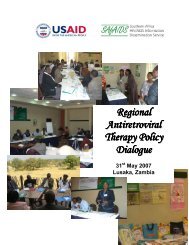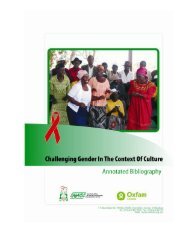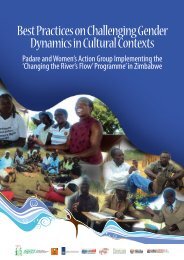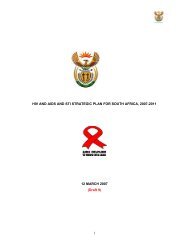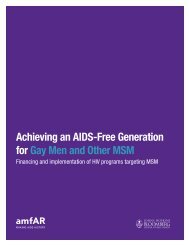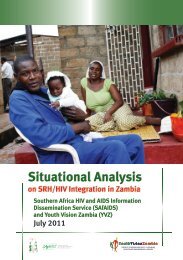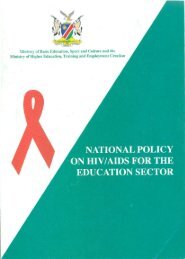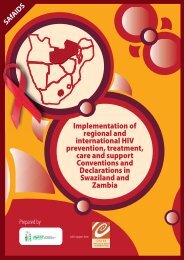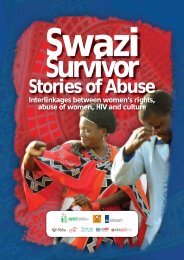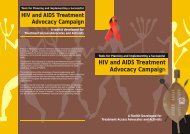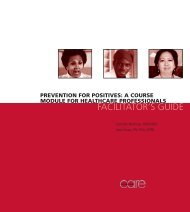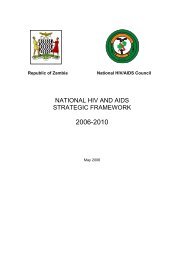A Success Story: The Etafeni Trust Fit for - SAfAIDS
A Success Story: The Etafeni Trust Fit for - SAfAIDS
A Success Story: The Etafeni Trust Fit for - SAfAIDS
Create successful ePaper yourself
Turn your PDF publications into a flip-book with our unique Google optimized e-Paper software.
At the core of these phases; and on-going, needs to be:<br />
• Regular monitoring and evaluation of processes and outcomes;<br />
• Visibility raising and marketing the programme to those who need it<br />
• Sustainability <strong>for</strong>ecasting, including fund-raising; innovative adaptation<br />
of the programme approach to meet evolving dynamics in the community<br />
being served, relevant to SRH and economic empowerment<br />
<strong>The</strong> impact being (a) increased levels of economic empowerment, (b)<br />
reduced vulnerability to poor SRH, and (c) improved sexual and reproductive<br />
health, <strong>for</strong> young people in the community reached by the intervention.<br />
Cycle of <strong>for</strong> Replication of the <strong>Fit</strong> <strong>for</strong> Life, <strong>Fit</strong> <strong>for</strong> Work A Six -<br />
Phased Approach<br />
5<br />
6<br />
PHASE 6: REPLICATION AND<br />
EXPANSION<br />
- Valoyi <strong>Trust</strong> in Tzaneen, rural<br />
- Hillbrow in Johannesburg, urban<br />
- Vrygrond in Cape Town, urban<br />
PHASE 5: LEARNING FROM REFLECTION<br />
- Marketing approach could change<br />
- Established collaborations with employers to<br />
enable graduate integration into world of work<br />
- Value add of the programme spread like ‘wild fire’<br />
- rein<strong>for</strong>cing the critical gap/need being<br />
closed/met by intervention<br />
4<br />
THE IMPACT<br />
- Increased levels of economic<br />
empowerment<br />
- Reduced vulnerability related to SRH<br />
- Improved sexual and reproductive health<br />
PHASE 4: IMPLEMENTATION<br />
- Advertise and select candidates<br />
- Hold trainings<br />
- Host graduation event and make it<br />
community/visibility raising event<br />
- Sustain post-graduation data-base<br />
- Develop and sustain partnerships<br />
1<br />
Monitoring<br />
Visibility-raising<br />
Sustainability-<strong>for</strong>ecasting<br />
PHASE 1: IDENTIFYING THE NEEDS<br />
- Appreciative enquiry of the environment<br />
and community<br />
- Identification of community needs<br />
- Mapping the prevalent social ills, to which<br />
one intervention could address multiple<br />
challenges<br />
3<br />
2<br />
PHASE 2: LEARNING THROUGH<br />
EXCHANGE VISITS<br />
- Identify a relevant programme from which<br />
learning can take place<br />
- Organize and go on learning exchange<br />
visit <strong>for</strong> on-site learning<br />
- Identify key structural, human resource and<br />
financial needs to establish programme<br />
PHASE 3: ADAPTATION AND SETTING-UP<br />
- Hold consultative meeting with community (leaders,<br />
beneficiaries, donors) to ensure participatory<br />
approach to set-up<br />
- Adapt and develop curriculum and integrate SRH and<br />
other focus areas, as per needs of community<br />
- Focus programme components on vulnerability of<br />
young women, backed by evidence base of their<br />
compromised societal status and vulnerabilities in<br />
your community<br />
- Secure start-up funding, build human capacity<br />
- Set criteria <strong>for</strong> participant selection<br />
- Develop a monitoring, tracking and reporting system<br />
21



